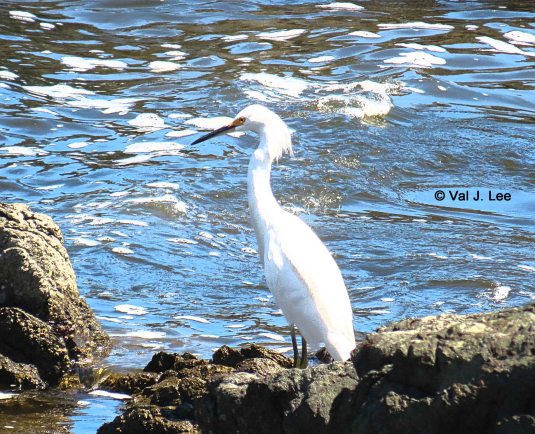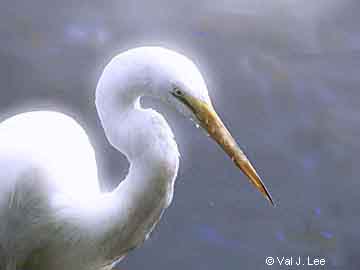I can’t tell you how thrilled I was to observe two Great White Herons; as well as the pristine coastal setting of Punta del este, Uruguay.
My husband and I trekked beside the edge of the ocean with eyes wide open in attempt to catch it all. There is a broad, concrete walkway; whereby we could behold a great deal of sea life.
We arrived at this port of call by water taxi, aka a tender, from our cruise ship.
The Great White Heron, above, is quite rare. It is recognized by its bright white, hanging feather headdress. Also displayed on the Great Blue Heron.
My video of Great White Heron:
I assumed I would never be able to see a Great White Heron, knowing they are incredibly rare. Many birders, even the world’s experts, surmise that Great Egrets are the Great White Herons, though they hold differences. These Egrets do not reveal the snow-white headdress that is always on display atop the Great White Herons.
An ornithologist, employed by Boise State University, informed me regarding the truth of these rare, exquisite specimens that exist on a small island in the lower Florida Keys.
A debate arose in our area of Idaho over a visiting, Great White Egret. A retired Boise State ornithologist, his wife and I were watching this elegant, white Heron at a wildlife area. I was thrilled to observe this shinning, white beauty! I had never seen an ave like it in Idaho, though I had in Florida:
Egrets are quite common there. The ornithologist, being a former teacher, naturally asked me if I knew what kind of bird it was. I was not absolutely sure, though obviously it resembled an Egret. He enthusiastically let me know that I was in the presence of a Great White Heron. What a privileged sighting I thought, until I sent an email and attached a photo of the Heron to our Audubon president, Pam. This was forwarded to birding experts. I received various opinions and info. The person, who seemed most knowledgable on the subject, was a current BSU ornithologist, who, as I mentioned above, seemed most accurate from what I personally researched. It was a Great White Egret not a Great White Heron.
Great White Herons display a long black or yellow beak with yellow or black legs set on yellow feet. Great White Egrets reveal a yellow beak and black legs on dark feet. The Snowy Egrets display a black beak and black legs on yellow feet. The Great Blue Herons reveal a yellow beak and dark grey legs on dark grey feet.
From my Uruguay photos, I noticed the legs on one of the Great White Herons to be yellow, topping matching yellow feet, and the other Great White revealed black limbs on yellow feet.
The White Herons in my photos do not reveal lower neck feather plumage; however, they are not often seen on the Great Blue Herons.
This growth appears as Heron’s age, the older the Blue Heron, the more lower throat feathers—and more impressive are its looks.
Of course, ornithologists relish in the classifications they place on birds as the “authorities,” though many of their dubbings change over time. I am not complaining, ornithologists are a great assist in the realm of birding assessment.
I do believe the Great White Heron is a unique Heron. It may simply be an easy tag for those Whites that do not stay in the lines.
The Great White Heron is close in appearance to the Great Blue Heron, excepting the bleached coloring and beak and leg hues.
Even in the Florida Keys, the home of the Great White Heron, there seems to not be a completely convincing argument regarding the Great White Heron:
http://blog.audubonguides.com/2011/04/11/wading-into-controversy-the-great-white-heron/
As you read here, the Florida Keys Great White Heron (lower right photo) also displays yellow legs, not the dark legs of the Blue Heron. What is the obvious difference with the Uruguay Great Whites and the Florida Keys Great Whites is the black beak.
The below information also states the Great White Herons are only located in this Florida Keys refuge. This is referring to their location in the United States. This is where the majority of this species congregate and where they live exclusively in America. The also dwell in the Yucatan Peninsula, and in the Caribbean. And, of course, I photographed them in Uruguay.
Info from US Fish and Wildlife:
Great White Heron National Wildlife Refuge was established in 1938 as a haven for great white herons, migratory birds, and other wildlife. Great white herons are a white color-phase of great blue herons and are only found in the Florida Keys. The refuge was created to protect great white herons from extinction. Great White Heron NWR is accessible only by boat.
http://www.fws.gov/nationalkeydeer/greatwhiteheron/
(I must personally add, I believe they were crafted by God in all their white glory from the beginning of creation.)
Interestingly, Wikipedia states Great White Herons and Great Egrets are the same.
You also have the Snowy Egret to compare to. If you peer at various Snowy Egret photos, you see how much resemblance there is to the Great White Heron overall.
Many Snowy Egrets will reveal a tall, head feather warbonnet and lower feather dress—expanding like a radiant full skirt; this during courtship exhibitions. The display and precision movements are amazingly gorgeous; all crafted by Jesus Christ. They also reveal long, poofy tail feathers, every season.
The Great White Heron’s upper headdress is not for breeding impressions, being viewed continually, as stated previously. The Great White Egret’s is a breeding presentation only.
It is also interesting to note that dark and white forms of the Great Blue Heron overlap in Florida. They are the intermediate Herons known as “Wurdemann’s Herons.” They have the body of a Great Blue Heron, but the white head and neck of the Great White Heron.
Years ago, I noted a Blue Heron that was quite lighter in color than the average. It lived in our local wildlife park. I am sure it would be classified as a Wurdemann’s, though it was in Idaho.
******
Great Blue Heron and Great White Heron interesting facts:
I appreciate the fact that some of the Blue Herons at our Boise, Idaho, “Katherine Albertson Park” of wildlife, do not mind me moving in with my camera. I love the varying details of this grand specimen that can contort to a multitude of poses when fishing—truly a must-see. The same is true of the Great White Heron. These Herons can be ballerina-like in their movements. White Herons are more so, wearing their prim, white dress that often becomes a full skirt.
You simply gaze on in amazement as you observe and watch the contortion of the necks of these Herons that often resemble an “S.” These proficient anglers always snatch their catch in a wink, but their work does not end there. They must maneuver their captured, finned critter down their long snake-like throats to reach the point of digestion.
One thing to note about these wingers is, they are loners. You never see a large Heron fishing with another.
The Great Herons are spectacular, photogenic, wading birds of the heron family Ardeidae (Blue Heron) and Ardea alba (White Heron).
The Great Blue Heron is an eye-catcher, and it is commonly viewed near the shores of open water—in wetlands over most of North and Central America, as well as the West Indies. It is a rare vagrant to Europe.
The Great Blue Heron is definitely the largest North American Heron, with a head to tail length of 36-55 inches. Plus, an impressive wingspan of 66-79 inches.
It weighs in at 4.6 pounds (on average). The Great White Heron may hold slightly smaller dimensions.
The Blue Heron is incredible in formation with azure feathers that cover the main body. It displays red-brown thighs, with a paired red-brown and black stripe up the flanks. Its neck is rusty-gray, with black and white streaking down the front. The crown is white, and its forehead, and sides of face. A pair of black plumes run from above the eye to the back of the head. The feathers on the lower neck are long and pluming.
Their bill is dull yellowish, becoming orange briefly at the start of the breeding season, along with its lower legs. Male and female are indistinctive.
The Great White Heron is, of course, completely snow white, except for its yellow or black legs, yellow feet and black or yellow bill.
Blues and Whites comb their down feathers with a claw on their middle toes, acting as a brush, removing all that yucky fish slime from their fishing times. They apply a powder that protects their feathers against the slime of swamps and ponds, as well as from the oily foods they consume. Obviously, they are uniquely and marvelously designed by Jesus Christ.
The call of Herons is a harsh loud croak. You can hear it from afar and it always catches my attention. For sure! Herons are most vocal during the breeding season.
The primary food for Herons is small fish, though they are also known to relish a range of shrimps, crabs, aquatic insects, rodents, other small mammals, amphibians, reptiles, and small birds.
It is fun to watch Herons consume their catch of the day, implementing their bills as swords. They spear it and swallow it whole. Yes, most amazing! Their angling habits are performed day and night.
I have heard Blue Herons flying in the dark; obviously trekking to their next fishing hole. God has granted them day and nocturnal vision for all their hunger needs. They most often roost for a good night snooze when the sun is setting.
My video of a Blue Heron roosting:
This species usually breeds in a monospecific (only of their kind) colony—a heronry; in trees close to lakes or other wetlands. A heronry may include other species of Herons.
The size of these colonies may be large, ranging between 5–500 nests per tree village. Several years ago, I saw such a colony. It was quite impressive … seeing all those nests in one tree.
The males are quite elaborate in their courting displays for the ladies with their concocting bodies, extended necks, bills raised to the sky, circling flights, as well as courtship noises for attention. God implements all of this to bond parents to raise their young as a team.
Parents take turns warming their unhatched young, consisting of three to six pale blue eggs. Once the wee ones are released from their shells, parents share in the responsibility of nourishment, regurgitating their caught prey to make it more like baby food during the first three weeks. The young will take directly from the beak from after this period, until the seven to eight-week mark, at which time, the young will fledge—soaring through the air in their first solo flight.
Herons are monogamous during the breeding season, raising one brood. They may or may not choose the same mate the following year.
Whites and Blues live an average of 15 years. One Blue holds the age record of 23 years. God has granted them great length of days.
The LORD Jesus Christ was most gracious to provide us with this glorious, structured being. He created everything according to His desires and omnipotently. Psalm 148 from the Bible, encourages our praise to God. Praise is commanded from the heavens and praise from the earth, because the LORD commanded and all things were created. The birds are commanded to praise Him—all of creation, including mankind, is to praise the LORD for His goodness in presenting creation.
*Info gratefully gathered from various web sources.
Letter to the bird Enthusiast: https://birdsbyval.wordpress.com/2012/03/03/letter-to-bird-enthusiast/
My South American Video Show: http://www.youtube.com/watch?v=vM72TIfUK-8&feature=c4-overview&list=UU1q-YrogeWMHltSTdCkspkQ










